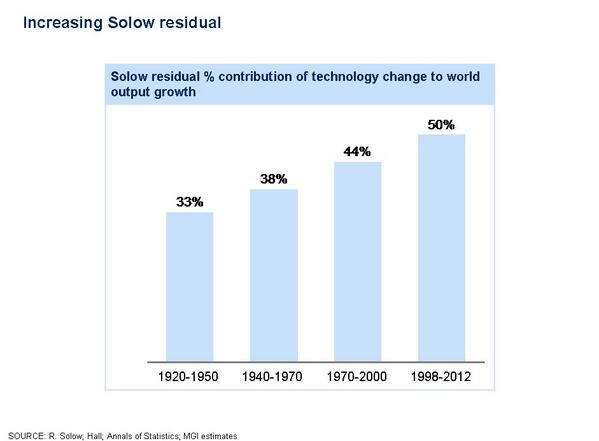Compared to expectations pre-crisis, Richard Dobbs of the McKinsey Global Institute suggests companies simply expect less growth than they once did.What is the "Solow Residual"? It is a stylized fact (or maybe just a myth) that the Solow Residual is, as stated in the title to the graph shown above, the "contribution of technology change to world output growth."
More technically, Mr Dobbs points to a steady rise in Solow’s Residual. Named for Robert Solow, the Nobel laureate economist, it refers to the proportion of growth that cannot be accounted for by extra labour or extra capital. From 1920 to 1950, this figure was about 33 per cent. Now, according to McKinsey, the Solow Residual has risen to 50 per cent.
Actually, as Konstantin Kakaes explained at Slate a few years ago, the Solow Residual does not actually refer to technological change:
Robert Solow, winner of the 1987 Nobel Memorial Prize in Economic Sciences, is famous for, in the recent words of a high-ranking State Department official, “showing that technological innovation was responsible for over 80 percent of economic growth in the United States between 1909 and 1949.”. . Typically, technical or technological progress isn’t explicitly defined by those invoking Solow, but people take it to mean new gadgets.Writing in 1956 about the role of productivity growth in the economy unexplained by labor and capital Moses Abramovitz lamented the existence of the unexplained residual factor, of which he said (here in PDF):
However, Solow meant something much broader. On the first page of “Technical Change and the Aggregate Production Function,” the second of his two major papers, he wrote: “I am using the phrase ‘technical change’ as a shorthand expression for any kind of shift in the production function. Thus slowdowns, speedups, improvements in the education of the labor force, and all sorts of things will appear as ‘technical change.’ ” But his willfully inclusive definition tends to be forgotten.
Solow was constructing a simple mathematical model of how economic growth takes place. On one side was output. On the other side was capital and labor. Classical economists going back to Adam Smith and David Ricardo had defined the “production function”—how much stuff you got out of the economy—in terms of capital and labor (as well as land). Solow’s point was that other factors besides capital, labor, and land were important. But he knew his limitations: He wasn’t clear on what those factors were. This is why he defined “technical change” as any kind of shift (the italics are his) in the production function. He wasn’t proving that technology was important, as economists in recent years have taken to saying he did. All Solow was saying is that the sources of economic growth are poorly understood.
[It] should be, in a sense, sobering, if not discouraging, to students of economic growth. Since we know little about the causes of productivity increase, the indicated importance of this element may be taken to be some sort of measure of our ignorance about the causes of economic growth in the United States.If the Solow Residual reflects a "measure of our ignorance" about economic growth, what does it say that it is growing in magnitude? Is our ignorance getting larger as well?
